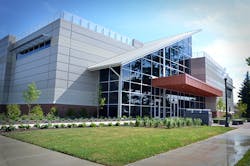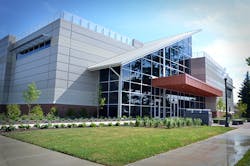College combines chilled beams, DOAS and radiant in unique geothermal HVAC design
FINDLAY, OHIO — Geothermal is continually becoming more commonplace in HVAC design. However one of the country's most innovative and sustainable HVAC systems at The University of Findlay's new $11 million Davis Building offers a futuristic view into the technology.
The award-winning science facility consisting of labs, classrooms and offices is drawing critical claim from the HVAC industry for its exceptional energy savings. Versus a conventional HVAC system, the HVAC system is saving 57percent more energy, which translates annually into a $59,000 energy savings and $7,500 in reduced maintenance. Its energy use index (EUI) is only 64 kBtu/ft2.
Geothermal is an innovative and green approach in itself, however, the Davis Building's design secret is the supplemental cutting-edge technology added by consulting engineer, Stephen Hamstra, P.E., LEED AP, president, Greensleeves LLC, Findlay, and RCM Architects, Findlay.
Instead of a conventional approach of heat pumps or unitary air handlers, for example, the 42,000-sq.ft. Davis Building's geothermal system supplies 58°F to 62°F closed circuit ground source water to ceiling-mounted, active chilled beams by SEMCO LLC, Columbia, Mo., for handling 70 to 80 percent of the sensible load. Chilled beams reduce fan energy by up to 50 percent versus conventional air handling technologies. Each chilled beam requires only 100 to 125-cfms from the project's 19,000-cfm dedicated outdoor air system (DOAS) to prevent condensation.
Furthermore, embedded 1/2-inch-diameter radiant PEX floor tubing by Viega, Wichita, Kan., leverages the thermal mass of the three-story building's poured concrete floors. All combined, the chilled beams, radiant and DOAS provide even cooling and heating temperatures that are well within the six degree differential guidelines of ASHRAE Standard 55: "Thermal Environmental Conditions for Human Occupancy."
All three systems draw from the 350-ft. deep, 40 well borefield's three hydraulically separated geothermal earth heat exchangers using vertical loops of high density polyethylene pipe (HDPE) manufactured by Blue Diamond Industries, Lexington, Ky.
Colorado’s State Capitol Building serves as beacon of sustainability
Geothermal install delivers net-zero for the newest Proud Green Home
"We see a tremendous opportunity with chilled beams and geothermal, especially north of the Mason-Dixon line where inherent ground temperatures of mid- 50's (degrees Fahrenheit) can be used in chilled beams and radiant systems," said Hamstra, who's considered one of the nation's leading geothermal design engineers with more than 5 million square feet of building space on his resume. "Instead of the 20 EER (energy efficiency ratio) of a conventional chiller system operating a majority of the time, the University of Findlay system achieves an estimated 150 to 200 EER."
The chiller, a 60-ton magnetic bearing chiller manufactured by Smardt, Plattsburgh, N.Y., runs about 20 percent less and is four times smaller than a conventional chiller in a similar sized building, which helped reduced the project's equipment capital costs. The resulting 700-sq.ft/ton is unprecedented for a science oriented building with 15 four to six-foot draft hoods, according to Hamstra who has previously specified three chilled beam projects.
Indoor Air Comfort
Hamstra specified 49 SEMCO Flexicool IQIC active chilled beams in four, six and eight-foot lengths. As the ceiling-mounted chilled beams quietly cool air around their coils, the cooler air sinks while warmer air rises in a perpetual room air mixing scenario that's superior in air comfort and energy efficiency compared to fan coils, variable air volume (VAV) and other forced air methods.
Installed by mechanical contractor, Jack's Heating A/C & Plumbing, Findlay, the chilled beams have adjustable slots (nozzles) to address specific areas in its airflow range. The balance of air and water temperatures are all controlled by the Niagara platform building automation system (BAS) manufactured by Tridium, Richmond, Va.
Hamstra also supplied each chilled beam room with a localized hot water reheat coil, manufactured by Trane, Tyler, Texas. "We reset the DOAS discharge temperatures based on what most zones are calling for," Hamstra explained. "The localized reheat coils can provide a more precise temperature required in that particular zone."
The outdoor air supplied through the active chilled beams also prevents potential floor condensation from the radiant system.
Hot water for the chilled beams and radiant system is supplied via chiller condenser heat recovery. An adjacent campus building's conventional boiler serves as a back-up, if needed.
Perhaps the most differentiating factor from other geothermal designs is the project's intuitive Greensleeves' software that optimizes efficiencies well beyond traditional building automation system parameters. Developed in-house by Greensleeves, the self-adapting, self-healing software provides several levels of predictive control based on the present and future temperature and humidity conditions of the building load, the loop and outdoor environment, while also managing the geothermal borefield. For example, the software might signal the chiller to increase the temperature of the radiant's thermal mass on a morning where trends predict additional cooling will be needed in the afternoon.
Greensleeves' software also intuitively manages the borefield via the project's hybrid wet/dry closed circuit cooling tower by Evapco, Westminster, Md. The cooling tower can be used to pull heat out during cooler nights, without the expense of running the chiller, so that the field can be more efficient the following day.
"The software perpetually runs building load analytics and then reprograms itself every five days for better efficiency in a self-adapting approach." said Hamstra.
Other innovative alternatives to conventional HVAC systems that are all controlled either with the Greensleeves' software or the BAS are:
· Fume hood systems by Phoenix Controls, Acton, Mass., and OptiNet air quality sampling system by Aircuity, Newton, Mass.;
· A packaged, factory-assembled energy chassis, manufactured by Armstrong Fluid Tech., Tonawanda, N.Y., that includes the chiller, how many seven pumps ranging from 1.5 to 15-hp VFD pumps, valves, piping, air separators, heat exchanges and sensors.
· A seven-zone geothermal variable refrigerant flow (VRF) system manufactured by Mitsubishi Electric, Suwanee, Ga. was used for stairwell and vestibule conditioning.
"I think the chilled beams will continue to take market share from heat pumps in geothermal designs," said Hamstra, who is also an ASHRAE Distinguished Lecturer. "However designers must consider condensation and humidity control along with DOAS. Another important consideration is getting the greatest capacity and efficiency from a geothermal system by using the warmest water temperatures possible for cooling and the coolest for heating."
Versus more conventional systems using a chilled water loop, chiller, cooling tower and VAV boxes with hot water coils, Hamstra's system is only $1/square foot higher in equipment costs, which amounts to approximately $75,000. The additional equipment expense will be paid back in less than two years and or pay back immediately if UF receives a proposed energy rebate from local utility AEP Ohio's energy efficient product installation program.
The Davis Building has also won first place in the 2014 ASHRAE Technology Awards program in the "New Educational Facilities" category. Although UF didn't apply for the Leadership in Environmental and Energy Design (LEED) program, Hamstra said the building would warrant at least Gold and possibly Platinum certification.
The Davis Building is currently the most efficient of UF's 2.5 million square feet of academic/athletic and residence buildings. "The building's performance monitoring is still ongoing, however we're presently attaining the energy savings that was proposed," said Myreon Cobb, Physical Plant Director, UF.



